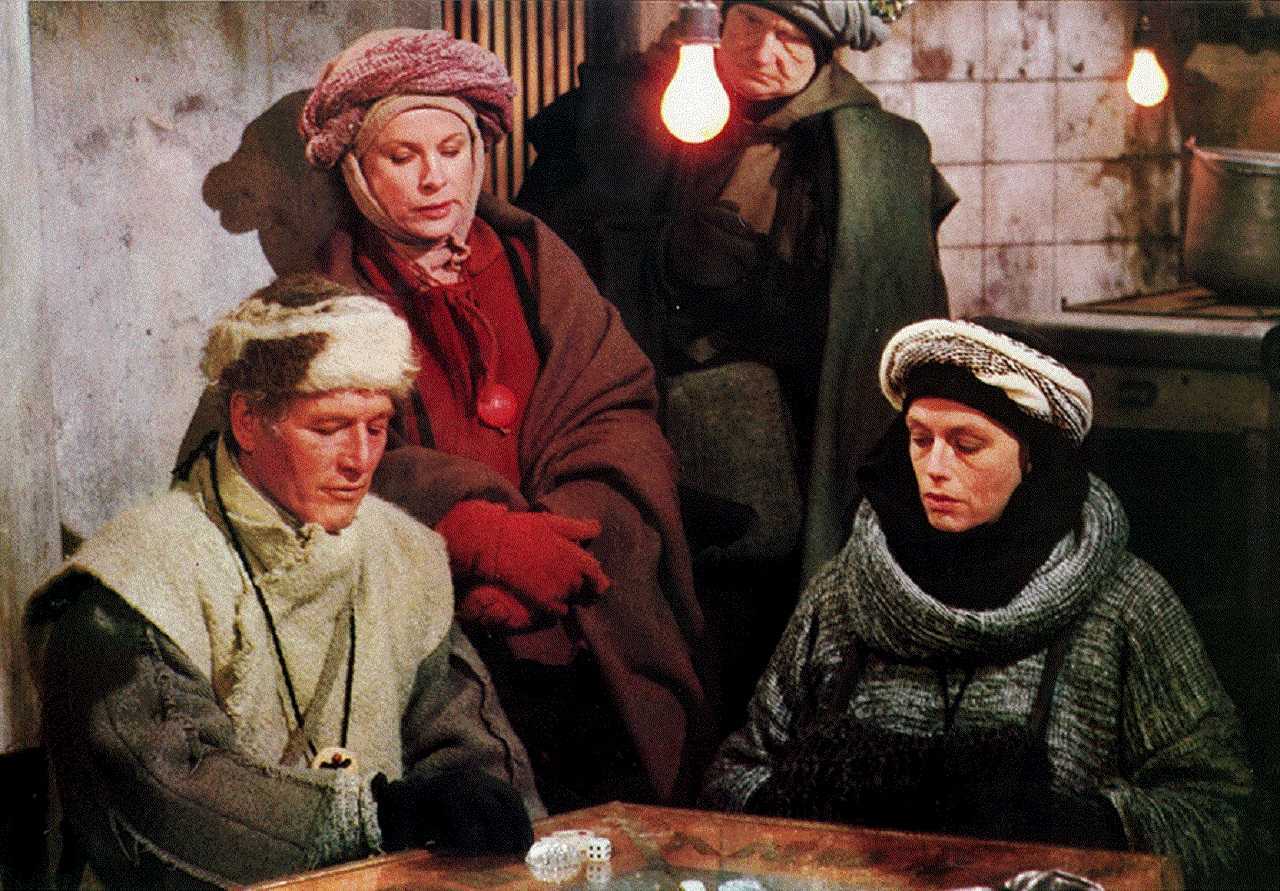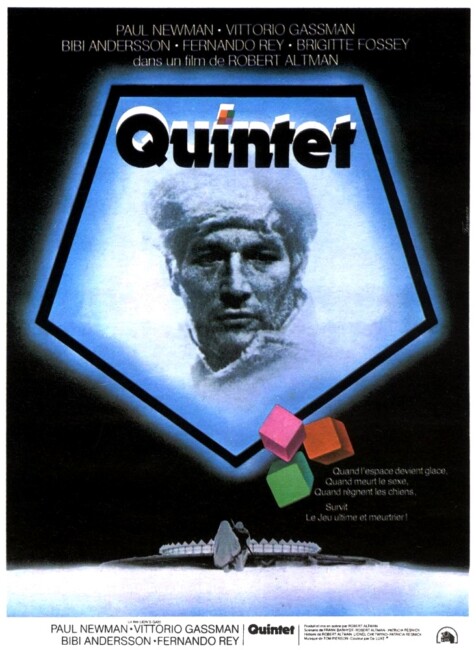Crew
Director/Producer – Robert Altman, Screenplay – Robert Altman, Frank Barhydt & Patricia Resnick, Story – Robert Altman, Patricia Resnick & Lionel Chetwynd, Photography – Jean Boffety, Music – Tom Pierson, Special Effects – Tom Fisher & John Thomas, Production Design – Leon Erickson. Production Company – Lion’s Gate/20th Century Fox.
Cast
Paul Newman (Essex), Fernando Rey (Grigor), Bibi Andersson (Ambrosia), Vittorio Gassman (St Christopher), Brigitte Fossey (Vivia), Nina Van Pallandt (Duca), David Langton (Goldstar), Tom Hill (Francha)
Plot
It is the future and the world has undergone another Ice Age. The seal hunter Essex comes out of the wilderness to visit his brother, bringing with him his wife Vivia who is one of the first women to become pregnant in a long time. In the decaying city, the bored populace spend their time playing the enigmatic dice game Quintet. Essex is invited to join a round of Quintet. However, while he is away getting wood for the fire, Vivia and the others are killed by a bomb blast. As Essex tries to stay alive, he seeks to understand the nature of Quintet in which people’s lives are forfeit when they lose.
Director Robert Altman (1925-2006) emerged in the early 1970s with acclaimed films such as M.A.S.H. (1970), Thieves Like Us (1971), McCabe and Mrs Miller (1971) and Nashville (1975). There Altman defined a distinctive style of dryer-than-dry humour, multi-stranded interweaving stories and affectedly naturalistic overlapping dialogue that seemed to happen in and around the main action. Although, at the same time as he was having these said hits, one must also remember that Altman was making bizarre experimental films such as the bafflingly absurdist Brewster McCloud (1971) about flying, angels and birds, and the identity-blurring surrealism of Images (1972) and 3 Women (1977).
By the end of the 1970s with successive flops like A Wedding (1978), A Perfect Couple (1979), Quintet and Popeye (1980), it appeared that the public’s taste for Robert Altman’s hits had been outweighed by those who had switched off in bafflement at his experiments. Over the next decade Altman became a weakened force, had developed a reputation with the studios as being difficult and cantankerous to work with and the 1980s is fairly much a dead zone as far as he is concerned. During this period, Altman was directing stage instead of film, moved to France for several years and then directed a series of very small budget experiments and films for cable television. Altman did however successfully stage a comeback in the 1990s with the hilarious Hollywood satire The Player (1992), followed by the likes of Short Cuts (1993), Pret-a-Porter (1994), Kansas City (1995) and Gosford Park (2001).
There are probably few that would be prepared to argue that Quintet is not Robert Altman’s worst film (although it does have a small coterie of defenders, including respected genre critic Peter Nicholls). Quintet is Robert Altman at his most bafflingly crypto-intellectual, where his proclivities towards enigmatic game-playing and pseudo-intellectualism are at their very worst. Quintet is a sort of like a crossbreed between Last Year in Marienbad (1961) and The Big Sleep (1946). Characters wander through the inscrutable plot muttering pretentious obscurities: “Five sides demand a sixth space – a centre you have to look forward to,” or “Life is merely a pause, an interruption in the void that precedes and follows it.” Everything is predicated on the number five – five levels of the city, the pentagonal architecture, five-sided hats and five players in the game.

One of the more frustrating things about the film, for instance, is that it never offers us any insight into how the game is played or what its rules are. None of this is exactly helped by the fact that most of the cast are non-native English speakers and deliver dialogue through accents. Although when it comes to the one native English speaker, Paul Newman, he looks equally as blank and confused by what is going on.
Certainly, Quintet‘s picture of the future is impressive – of beautifully fragile glass sets amid the overpoweringly desolate, almost monochromatically white Canadian winter locations. (All of the interiors were shot amid the frozen ruins of a former Montreal World Expo site during the height of winter). Altman packs the background with small details that make for an often impressively rounded and three-dimensional future – packs of dogs gnawing on the bodies of the dead, Paul Newman and Brigitte Fossey’s amazement at seeing a bird flying overhead. The bleak frozen photography is impressive, although the entire film has been shot as though the cameraman had coated the lens with vaseline. There is also an annoyingly discordant score.
Robert Altman’s other films of genre interest are:– Countdown (1967) about a Moon landing mission; the completely gonzo Brewster McCloud (1971) about a young man who is invoked to build a set of wings by an angel; Images (1972) with its surreal games of identity blurring; 3 Women (1977), a cryptic film about identity blurring; Popeye (1980), a live-action adaptation of the famous comic-strip; and A Prairie Home Companion (2006), an ensemble film based on the famous radio show, which features a visiting angel of death.


